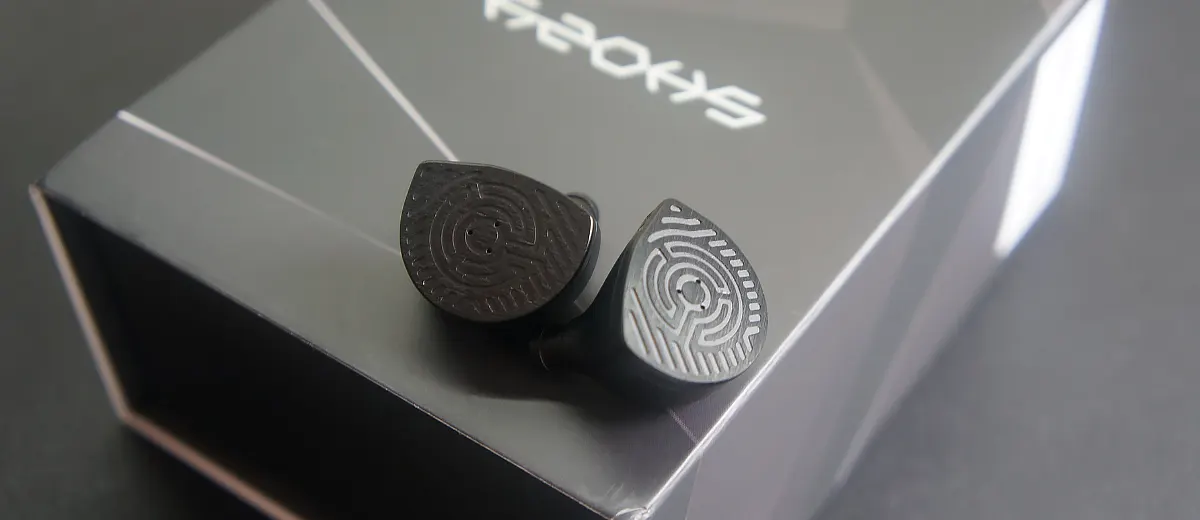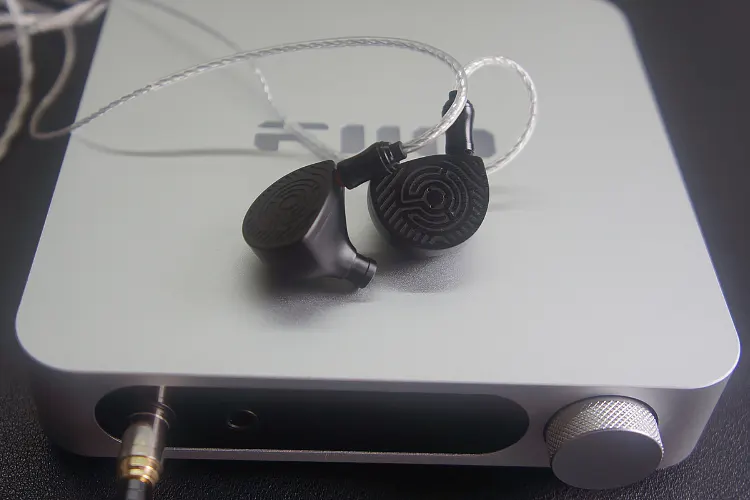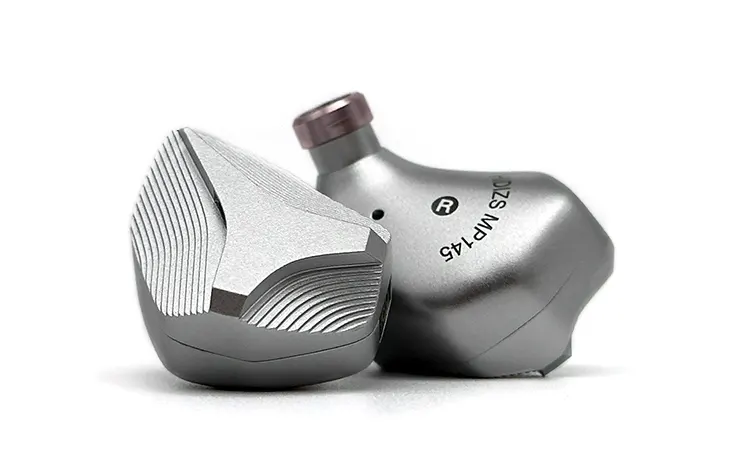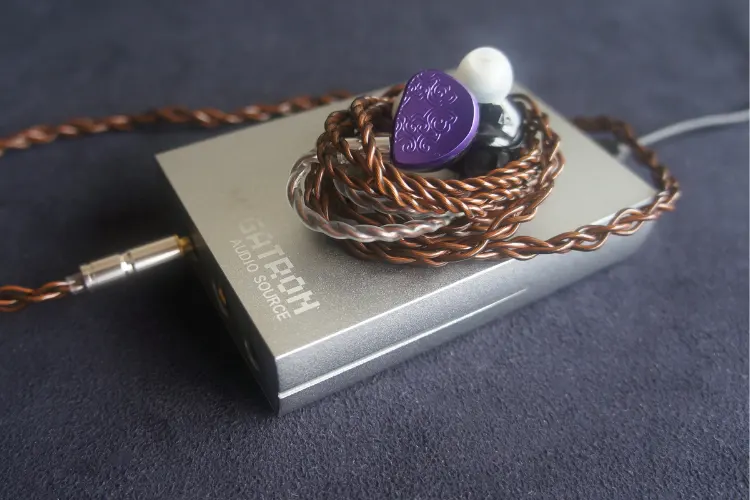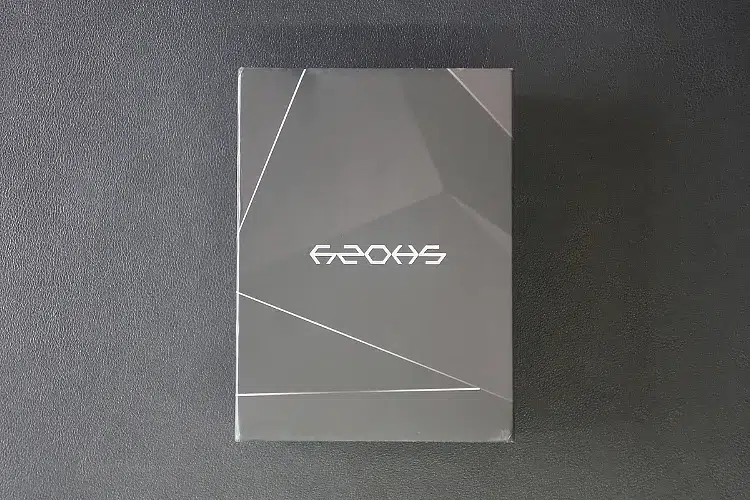Synergy
Efficiency
The P20 has an impedance of 30Ω and a sensitivity of 105 dB/mW, making it drivable by laptops and the few smartphones that still have a headphone jack. However, its low-end response and resolution performance benefit quite a bit from a more powerful amplifier or a dongle DAC.
Throughout my on-the-go testing and using its stock 3.5mm cable, I paired it with the 7hz SEVENHERTZ 71, the ddHiFi TC35 Pro E2 dongle DAC, and the FiiO K11 desktop DAC/AMP.
I found that I was still able to get full extension and resolution in the sub-bass and treble regions with the two dongle DACs.
For desktop use, I paired it with the FiiO K11 through its SE output. The FiiO K11 can adequately drive the P20 to listening levels at around 60% volume on the medium gain setting.
Through the desktop amplifier, I found that the sub-bass hums and droning tones had slightly more texture, but the overall slam and impact of the bass notes were similar between the K11 and the ddHiFi TC35Pro E2.
In my testing, my daily driver ddHiFi TC35Pro Eye2 lightning dongle sufficiently drove the P20, In practice, I never even came close to reaching the maximum output of the TC35Pro E2, even when going slightly above normal listening levels.
Pairings
The P20 can pair well with a variety of sources, DAPS, and dongles. However, since the 7Hz SEVENHERTZ 71 is a warmer-sounding dongle, I preferred pairing it with the more neutral-sounding ddHiFi TC35Pro E2.
I found that the additional warmth in the P20 tuning and the already thick sub-bass performance contributed to slight levels of bass bleed.
During my desktop usage, or in any situation where I could use a more powerful desktop-class amplifier, I powered the P20 with my FiiO K11. I did not find the need to pair it with a more powerful amplifier since the SE performance of the K11 was already sufficient to maximize the performance.
Select Comparisons
Hidizs MP145
Technical
The Hidizs MP145 and the Shozy P20 both use a single 14.5mm planar magnetic driver, making a comparison between these two IEMs quite relevant.
The MP145 has an impedance and sensitivity of 30Ω and 104 dB/mW, while the Shozy P20 has the same impedance of 30Ω and a slightly higher sensitivity of 105 dB/mW. In practice, both IEMs were quite similar in terms of drivability.
Design
The Hidizs MP145 shell is constructed from CNC-machined aluminum with an ergonomic whale-inspired form factor. The geometric shapes of the MP145 make it visually stand out, especially with the metallic finish of the shell material used.
In contrast, the P20 also uses a full aluminum shell, however, its faceplate designs are less 3 dimensional, instead opting for a simple circular pattern on a brushed aluminum panel. This is in contrast to the anodized aluminum finish used in the MP145.
In day-to-day usage, I found that the P20 was observably more comfortable than the MP145 due to its lighter construction, and more ergonomic shape fitting my ear better.
Performance
The P20 has a more prominent V-shaped sound signature when compared to the already V-shaped signature of the MP145
The P20 has a stronger and deeper bass performance, not only delivering a more intense chest-shaking sensation but doing so with better texture and detail retrieval in the low-end notes. This contributes to the P20 having a more exciting sound signature.
Another stand-out is the sheer difference between the two IEMs in playing back hums and rumble. The P20 can do so while maintaining very good texture and nuance, while the MP145 comes off playing it as a single note, with these rumbles being inaudible in more complex arrangements.
The mid-range of the P20 is significantly more resolving than that of the MP145. I found this quite interesting since I rarely encountered a situation wherein the more exciting-sounding IEM was also more technically proficient and resolving.
When comparing vocals between the two IEMs, the vocals coming from the MP145 sounded muffled and compressed, not even coming close to the level of air and vocal energy that the P20 can playback.
The P20’s treble is presented with more resolution and air than the MP145. Each cymbal strike on the P20 resonates with more energy, creating a livelier listening experience.
As mentioned earlier, the P20 achieves this level of top-end proficiency without coming off as too metallic or clinical sounding. I never found the P20 coming off as sibilant. The P20 simply outclasses the MP145’s treble in both technicality and enjoyability.
Tangzu Zetian Wu
Technical
Both the Tangzu Zetian Wu and the Shozy P20 make use of a single 14.5mm Plana Magnetic driver, once again making this quite an interesting comparison.
The P20 has an impedance and sensitivity of 30Ω and 105 dB/mW, while the Zetian Wu has a lower impedance of 16Ω and a lower sensitivity of 100 dB/mW.
Design
The Zetian Wu uses a shell constructed from 3D-printed semi-translucent resin with a dark glossy finish. It has a separate metal face plate with a brushed purple finish with oriental-inspired engravings on each faceplate.
In comparison, the P20 has a black anodized aluminum shell with a separate body and faceplate as well. The P20’s faceplate is constructed out of brushed aluminum with circular patterns engraved in front.
This makes the Zetian Wu significantly lighter than the P20, a fact that becomes obvious when comparing the in-ear comfort of both IEMs.
I found that the lighter-weight shell of the Zetian Wu made it more comfortable than the P20, but the P20 is by no means uncomfortable.
Performance
The Zetian Wu has a slight V-shaped sound signature that leans towards the warm end while the Shozy P20 has a more prominent V-shape.
The P20 has a fuller, deeper, and harder-hitting bass than the Zetian Wu in any track I tried. Comparing deep percussive tones between the two IEMs highlights a night and day difference, wherein the P20 can playback bass that is felt in your chest, while the Zetian Wu plays back bass with merely average note weight and texture.
In low-end rumble, the P20 slightly edges out the Zetian Wu, being able to once again playback these notes with a level of texture that cannot be matched by the IEMs I’ve compared against.
However, the warmer tonality of the Zetian Wu gives it an advantage for deeper atmospheric bass guitar strums wherein it can deliver better note weight and an overall fuller tone.
The mid-range comparison of the Zetian Wu and the P20 is somewhat of a mixed bag, the P20 is more resolving and technically proficient than the Zetian Wu, but the Zetian has a more organic sound signature, especially in brass instruments.
The P20’s high frequencies exhibit notably greater clarity and brilliance when compared to those of the Zetian Wu. Cymbal strikes, chimes, and even vocals in the upper register are delivered with a refreshing sense of openness and liveliness by the P20.
It is important to note that the Zetian Wu has a substantially wider and more immersive sound stage compared to the P20, making the tracks feel more atmospheric. But given this, the P20’s imaging performance is superior to the Zetian Wu’s.
Simgot EA500LM
Technical
Inside the Simgot EA500LM is a single Lithium Magnesium dynamic driver, while the P20 also has a single driver, but instead opts for a 14.5mm planar magnetic driver.
The Simgot EA500LM has an impedance of 16Ω and a sensitivity of 106 dB/mW, while the P20 has an impedance of 30Ω and a sensitivity of 105 dB/mW. In practice, I found the EA500LM was easier to drive than the P20.
Design
Both EA500LM and Shanling Sono have an all-metal build, with the metal used on the EA500LM being a darker shade, giving it a shiny yet subdued aesthetic.
The P20 opts for anodized and brushed aluminum instead of mirror-like metal, giving it a stealthy aesthetic with a simple geometric pattern on its faceplate.
Because of its mirror finish, I found that the Simgot was much more of a fingerprint magnet, making it harder to maintain day-to-day. I found the P20 to be more comfortable than the EA500LM as well because of its lighter shell.
Performance
I found that the P20’s sub-bass hits deeper with a stronger and more visceral impact. Aside from the strength of the bass, I noticed that the texture and good decay performance is further highlighted when compared to the EA500LM.
Bass notes on the EA500LM are still decently textured, but their notes are “one and done”, wherein the decaying texture of the P20’s bass adds more to the overall tapestry of sounds being played back in complex mixes.
Despite this, the EA500LM had a more forward mid-bass compared to the P20, with hums and rumble being emphasized within the mix through the EA500LM.
The P20 outclasses the EA500LM in terms of technicalities and tonality. When listening to delicate female vocals, the P20 can play back the subtle nuances and tenderness in the singer’s voice, while the EA500LM plays them back with much duller detail.
The P20 also has a more natural and pleasing tonality compared to the sharp and clinical mid-range tonality of the EA500LM. The EA500LM’s vocals sounded more fatiguing and grating.
The vocal performances sounded closer to live music on the P20, while the EA500LM sounded like it was coming from a compressed digital mix.
The EA500LM’s treble is much colder in addition to being quite resolving. However, I noticed that the resolution performance of the P20 was on par with the EA500 LM’s, and it pairs this with a more pleasing and less clinical tonality.
Our Verdict
The Shozy P20 is another entry into the sea of single 14.5mm Planar Magnetic IEMS but brings good tuning, resolution, and texture performance, especially given the price point.
Its build, design, and package inclusions are quite spartan for the price, but it more than makes up for it with its performance.
Based on my testing, it is one of the better-tuned single planar driver IEMs, never coming off as too clinical or sibilant, while also ensuring its bass does not bleed into other portions of the mix.
Audiophiles picking up their first planar IEM may want to consider the P20, since it highlights the driver configuration’s good technical performance, without sacrificing an enjoyable listening experience.
Shozy P20 Technical Specifications
- Driver Type: Single 14.5mm Planar Magnetic Driver
- Plug: 3.5mm SE or 4.4mm BAL
- Frequency Response: 5Hz-40kHz.
- Impedance: 30 Ohm.
- Sensitivity: 105dB.

